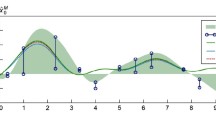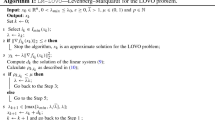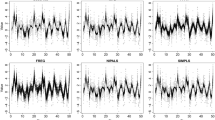Abstract
By analyzing the structure of the objective function based on error sum of squares and the information provided by the objective function, the essential problems in the current parameter estimation methods are summarized: (1) the information extracted from the objective function based on error sum of squares is unreasonable or even wrong for parameter estimation; and (2) the surface of the objective function based on error sum of squares is more complex than that of the parameter function, which indicates that the optimal parameter values should be searched on the surface of the parameter function instead of the objective function. This paper proposes the concept of sample intersection and demonstrates the uniqueness theorem of intersection point (namely the uniqueness of optimal parameter values). According to the characteristics of parameter function surface and Taylor series expansion, a parameter estimation method based on the sample intersection information extracted from parameter function surface (PFS method) was constructed. The results of theoretical analysis and practical application show that the proposed PFS method can avoid the problems in the current automatic parameter calibration, and has fast convergence rate and good performance in parameter calibration.
Similar content being viewed by others
References
Burke J V, Ferris M C. A Gauss-Newton method for convex composite optimization. Math Program, 1995, 71: 179–194
Rosenbrock H H. An automatic method of finding the greatest of least value of a Function. The Comp J, 1960, 3: 303–307
Powell M J D. An efficient method for finding the minimum of a function of several variables without calculating derivatives. The Comp J, 1964, 7: 155–162
Pickup G. Testing the efficiency of algorithms and strategies for automatic calibration of rainfall-runoff models. Hydrol Sci Bull, 1977, 22(2–6): 257–274
Sorooshian S, Brazil E L. Comparison of Newton-type and direct search algorithms for calibration of conceptual rainfall-runoff models. Water Resour Res, 1988, 24(5): 691–700
Hofmann B. On the degree of ill-posedness for nonlinear problems. J Inverse III-posed Prob, 1994, 2(1): 61–76
Hofmann B, Scherzer O. Factors influencing the ill-posedness of nonlinear problems. Inverse Probl, 1994, 10(6): 1277–1297
Beven K. A manifesto for the equifinality thesis. J Hydrol, 2006, 320(1–2): 18–36
Hooke R, Jeeves T A. Direct search solutions of numerical and statistical problems. J ACM, 1961, 8(2): 212–229
Ibbitt R P, Donnell T O’. Designing conceptual catchment models for automatic fitting methods. In: Proceedings of International Symposium on Mathematical Models in Hydrology, International Association of Hydrological Science, Warsaw, 1971
Francine M. Using a genetic algorithm combined with a local search method for the automatic calibration of conceptual rainfall-runoff models. Hydrolog Sci J, 1996, 41(1): 21–40
Cheng C T, Wang W C, Xu D M, et al. Optimizing hydropower reservoir operation using hybrid genetic algorithm and chaos. Water Resour Manag, 2008, 22(7): 895–909
Blum C. Ant colony optimization: Introduction and recent trends. Phys Life Rev, 2005, 2(4): 353–373
Yang J G, Zhuang Y B. An improved ant colony optimization algorithm for solving a complex combinatorial optimization problem. Appl Soft Comput, 2010, 10(2): 653–660
Chau K W. Particle swarm optimization training algorithm for ANNs in stage prediction of Shing Mun River. J Hydrol, 2006, 329(3–4): 363–367
Jiang Y, Liu C M, Huang C C, et al. Improved particle swarm algorithm for hydrological parameter optimization. Appl Math Comput, 2010, 217: 3207–3215
Hopfield J, Tank D. ‘Neural’ computation of derisions in optimization problems. Biologieal Cyberneties, 1985, 52: 141–152
Duan Q Y, Sorooshian S, Gupta V. Effective and efficient global optimization for conceptual rainfall-runoff models. Water Resour Res, 1992, 28(4): 1015–1031
Duan Q Y, Gupta V K, Sorooshina S. Shuffled complex evolution approach for effective and efficient global minimization. J Optimiz Theory App, 1993, 76(3): 501–521
Gupta H V, Sorooshian S, Yapo P O. Status of automatic calibration for hydrologic models: comparison with multilevel expert calibration. J Hydrol Eng, 1999, 4 (2): 135–143
Franchini M, Galeati G. Comparing several genetic algorithm schemes for the calibration of conceptual rainfall-runoff models. Hydrolog Sci J, 1997, 42 (3): 357–379
Goswami M, O’Connor K M. Comparative assessment of six automatic optimization techniques for calibration of a conceptual rainfall-runoff model. Hydrolog Sci J, 2007, 52(3): 432–449
Xia Y, Pitman H V, Gupta M, et al. Calibrating a land surface models of varying complexity using multi-objective methods and the Cabauw data set. J Hydrometeorol, 2002, 3:181–194
Engeland K, Braud I, Gottschalk L, et al. Multi-objective regional modeling. J Hydrol, 2006, 327(3–4): 339–351
Gupta H V, Sorooshian S, Yapo P O. Toward improved calibration of hydrologic models: Multiple and noncommensurable measures of information. Water Resou Res, 1998, 34(4): 751–763
Bao W M. The research about calibrating model parameters (in Chinese). Doctoral Dissertation. Nanjing: Hohai Univ, 1989
Bao W M. Automatic calibration of the Xinanjiang model (in Chinese). J Hohai Univ (Natural Sci.), 1986, (4): 22–30
Li Q, Bao W M, Zhang B, et al. Conceptual hierarchical calibration of Xinanjiang model. 3rd International Symposium on Methodology in Hydrology, IAHS Publ 350, 2011. 690–697
Bao W M. Parameter estimation of the model with colored noise (in Chinese). J Hydraul Eng, 1991, (12): 47–52
Bao W M, Ji H X, Hu Q M, et al. Robust estimation theory and its application to hydrology (in Chinese). Adv Water Sci, 2003, 14(4): 133–137
Bao W M, Lin Y, Huang X Q, et al. Parameter robust estimation of reach flood concentration model (in Chinese). Eng J Wuhan Univ, 2004, 37(6): 13–17
Zhao C, Bao W M, Wang Y Q, et al. Robust estimation of reach flow concentration parameters (in Chinese). J Hohai Univ (Nature Sci), 2006, 34(1): 14–17
Bao W M, Wang H, Zhao C, et al. Robust estimation of AR model parameters (in Chinese). J Hohai Univ (Nature Sci), 2006, 34(3): 258–261
Zhao C, Hong H S, Bao W M, et al. Robust recursive estimation of auto-regressive updating model parameters for real-time flood forecasting. J Hydrol, 2008, 349(3–4): 376–382
Bao W M, Li Q. Estimating selected parameters for the XAJ model under multicollinearity among watershed characteristics. J Hydrol Eng, 2012, 17(1): 118–128
Bao W M, Li Q, Li C S. The weighed objective functions based on sensitivity analysis (in Chinese). J Hydroelectric Eng, 2013 (accepted)
Li Q, Bao W M. The estimation of concentration parameters based on the Fourier (in Chinese). Water Resour power, 2011, 2: 33–38
Bao W M, Si W, Qu S M. The linearized calibration method of non-linear function parameter (in Chinese). Chin J Comp Mech, 2013, 30(2): 236–241
Bao W M, Li Q. An efficient calibration technique under the irregularity response surface. J Hydrol Eng, 2013, http://dx.doi.org/10.1061/(ASCE)AE.1943-5584.0000719
Nelde J A, Mead R. A simplex method for function minimization. The Computer J, 1965, (7): 308–313
Zhao R J. The Xinanjiang model applied in China. J Hydrol, 1992, 135(4): 371–381
Yao C, Li Z J, Bao H J. Application of a developed Grid-Xinanjiang model to Chinese watersheds for flood forecasting purpose. J Hydrol Eng, 2009, 14(9): 923–934
Hu C H, Guo S L, Xiong L H. A modified Xinanjiang model and its application in northern China. Nordic Hydrol, 2005, 36(2): 175–192
Cheng C T, Zhao M Y, Chau K W. Using genetic algorithm and TOPSIS for Xinanjiang model calibration with a single procedure. J Hydrol, 2006, 316(1–4): 129–140
Author information
Authors and Affiliations
Corresponding author
Rights and permissions
About this article
Cite this article
Bao, W., Zhang, X. & Zhao, L. Parameter estimation method based on parameter function surface. Sci. China Technol. Sci. 56, 1485–1498 (2013). https://doi.org/10.1007/s11431-013-5224-3
Received:
Accepted:
Published:
Issue Date:
DOI: https://doi.org/10.1007/s11431-013-5224-3




